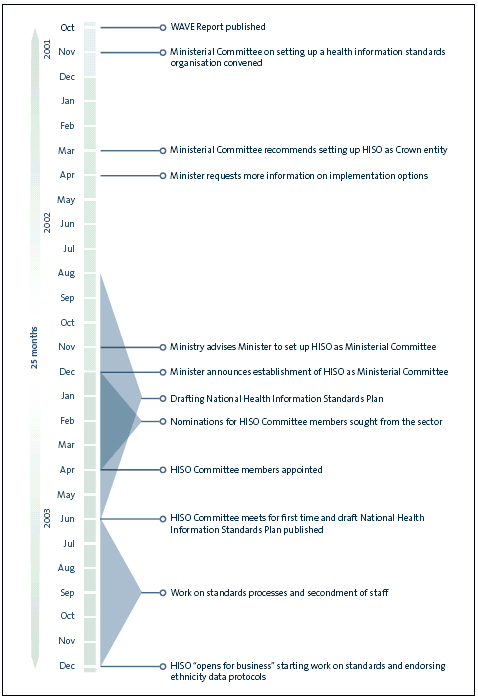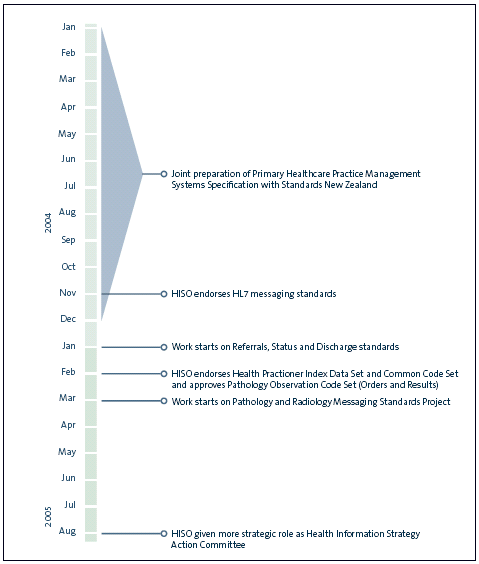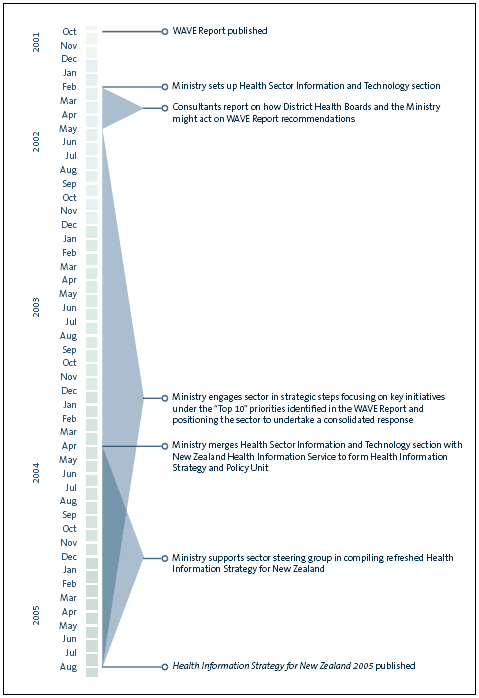Part 2: Response to the WAVE Report
2.1
In this Part, we:
- briefly explain the background to the WAVE Report; and
- discuss how the Ministry and the sector have responded to the WAVE Report.
Background to the WAVE Report
2.2
The strategic importance of information management and information technology to the delivery of health services was first indicated in 1991 when the Department of Health, as it was then known, published the Health Information Strategy. The Ministry updated the strategy in 1996 with the Health Information Strategy for the Year 2000.
2.3
In 2000, the Ministry produced a draft Health Knowledge Strategy, which reflected a strategic shift in the delivery of health services towards areas of highest benefit for the population and to tackling inequalities. To build on the Health Knowledge Strategy, the Ministry established the Working to Add Value Through E-Information (WAVE) Project.
Appointment of the WAVE Advisory Board
2.4
In December 2000, the Director-General of Health appointed a WAVE Advisory Board. The role of the WAVE Advisory Board was to facilitate the preparation and acceptance by the sector of a 3- to 5-year information management and information technology plan. The goal was to improve health outcomes through the effective use of health information at the least cost to the sector.
2.5
The WAVE Advisory Board included representatives from a range of sector interests. It was supported by a project executive and a core team of staff from the Ministry, DHBs, and the New Zealand Health Information Service.
2.6
By bringing together sector stakeholders through the WAVE Advisory Board, the Ministry was seeking to actively engage the sector in setting policy on information management and information technology.
Priorities for action identified in the WAVE Advisory Board’s report
2.7
The WAVE Advisory Board published the WAVE Report in October 2001. The WAVE Report was broad in scope, looking at information management and information technology issues for all 21 DHBs, and some 13,000 other provider organisations in the sector. It considered more than 300 information systems and data sets.
2.8
The WAVE Report was not a detailed plan of action but presented the WAVE Advisory Board’s advice on the main actions that the Ministry and the sector should take to gain better value from the use of electronic health information. It contained 79 recommendations, including the “Top 10” priorities (see Figure 1 in Part 1).
2.9
Stakeholders from throughout the sector told us the WAVE Report provided a good basis for enhancing health information management and information technology, because it was a consolidated view of the sector’s priorities, and was supported by the sector.
How the Ministry of Health and the sector have responded to the WAVE Report
2.10
The Ministry and the sector did not prepare a detailed plan with measurable objectives for implementing the WAVE Report, as we would have expected. Instead, the Ministry decided to work with the sector and concentrate action on the priorities of the WAVE Report by:
- setting up a health information standards organisation; and
- applying 4 strategic steps.
2.11
The Ministry told us that it chose to take this particular course of action because it considered the sector was not in a position, culturally or structurally, to plan a detailed implementation response. It did not want to lose the momentum generated by producing the WAVE Report, nor lose sector confidence in the ability of the Ministry to take action.
2.12
In our view, while the Ministry’s response was reasonable and pragmatic, some focus and impetus was lost by not having a detailed plan with measurable objectives.
Setting up an independent health information standards organisation
2.13
In the view of the WAVE Advisory Board, the most important recommendation in the WAVE Report was to –
… set up an independent organisation to lead [information management and information technology] capability.
2.14
The WAVE Advisory Board recommended that a New Zealand Health Information Standards Organisation should be set up as a Crown entity to determine sector information management and information technology standards, with a governing board appointed by the Minister of Health and the Minister of Finance.
2.15
The WAVE Advisory Board believed that such an organisation would effectively lead the sector’s response to the WAVE Report, and bring about sector-wide collaboration and coherence to continuously improve systems and data quality over time. The organisation would do this by working to get agreement on important components such as common electronic languages and data sets.
2.16
The WAVE Advisory Board considered that, to ensure enough support from the sector and to continue momentum from the WAVE Report, the organisation should be independent of the Ministry.
Working group advises on establishing new organisation
2.17
When launching the WAVE Report in October 2001, the Minister of Health said that efficient information management was essential to the delivery of quality health care, and that, in an international context, New Zealand was seen as one of the leaders in “developing” and using health information.
2.18
The Minister said that, while New Zealand had made a good start with health information management, there was much room for improvement, and urged the sector not to lose the momentum behind the WAVE Report. The Minister noted that “a strong base for a successful response, which many of you [in the sector] have active roles in, can now be put in place”.1
2.19
The Minister said a working group would be appointed to advise on establishing a health information standards organisation, and on priorities for information standards.
2.20
The working group was convened in November 2001. In March 2002, it recommended establishing a Crown entity – with a governing board, and able to employ staff – as the best option for establishing a health information standards organisation. The working group considered that a Crown entity would be seen as more independent and therefore more effective.
2.21
Another less preferred option was a Ministerial Committee, which the working group said had the advantage of being easily implemented.
The Health Information Standards Organisation was not as independent of the Ministry of Health as recommended by the working group
2.22
On receiving the working group’s report, the Minister requested more information from the Ministry’s Corporate Information Directorate about the options for establishing a health information standards organisation.
2.23
In November 2002, as part of a staged approach to implementing the working group’s recommendations, the Ministry recommended that the health information standards organisation be established immediately – as a Ministerial Committee.
2.24
The Ministry considered that it was not feasible to establish a Crown entity (as recommended by the working group) because of funding constraints, and the time required to work through the establishment, governance, and long-term funding details. Sector stakeholders and the Ministry had also found it difficult to agree on the form, mandate, and funding for a Crown entity.
2.25
In December 2002, the Minister announced the establishment of the Health Information Standards Organisation (HISO) as a Ministerial Committee.
2.26
The Ministry’s proposed staged implementation for HISO envisaged that the structure of the organisation would change from a Ministerial Committee to an independent organisation by 2004-05. This has not happened. It has taken time for the sector to recognise HISO as independent of the Ministry (reporting to the Minister of Health rather than the Ministry) and to attract the level of funding from the sector that was expected by the working group. In the meantime, the Ministry has supported HISO with resources and with funding, providing funding beyond what it originally expected (see paragraphs 2.31 to 2.35).
The Health Information Standards Organisation “opened for business” 25 months after the WAVE Report was published
2.27
The Ministry expected that HISO Committee members would be appointed within one month of the Minister’s announcement in December 2002, and meet for the first time in January 2003.
2.28
There was a delay caused by post-election activity at the time and, while the HISO Committee’s terms of reference were being prepared, sector nominations were sought and a draft Health Information Standards Plan was prepared in consultation with the sector as a starting point for HISO’s work programme.
2.29
Members were appointed in April 2003, after the sector submitted candidates. The HISO Committee’s first meeting in June 2003 was aligned with the launch of the draft Health Information Standards Plan.
2.30
HISO was formally established by notifying the House of Representatives in July 2003, as required by the New Zealand Public Health and Disability Act 2000. After putting in place processes based on Standards New Zealand practice and identifying priority standards that needed to be prepared, HISO “opened for business” in December 2003 – one year after the Minister’s announcement that HISO would be a Ministerial Committee, and 25 months after the WAVE Report was published (see Figure 2).
Funding from the sector, and staffing, have not yet reached the expected levels
2.31
The working group noted that HISO must establish and maintain credibility with the sector and that one indicator of credibility would be the amount of resources allocated to the organisation. The working group suggested that HISO should have an annual operating budget of between $800,000 and $1 million.
Figure 2
Timeline for setting up the Health Information Standards Organisation

* The HISO Committee Chairman informed the Minister of Health that HISO "opened for business" from 1 December 2003.
2.32
In the financial year that HISO “opened for business” (July 2003 to June 2004), the Ministry provided funding of $300,000, with the balance of up to $800,000 expected to come from the sector. Funding in subsequent years of up to $800,000 a year was expected to come entirely from the sector.
2.33
So far, the sector has not provided the expected funding to support HISO and the Ministry has continued to give the organisation up to $300,000 a year.
2.34
Figure 3 compares the working group’s main recommendations for staffing and funding with how HISO was set up. It shows that HISO has had resources well below those recommended by the working group and planned by the Ministry.
2.35
HISO’s effectiveness relies on sector acceptance and support, not just with funding but also in responsiveness to, and engagement in, work to prepare standards. Recently, HISO has found the sector more responsive and engaged, and the sector has committed to providing more funding, although this is still well below the recommended and planned amounts.
Figure 3
Funding and staffing of the Health Information Standards Organisation
The Ministry has continued to support HISO but the organisation has not had the funding or staff numbers recommended by the working group.
| Recommendation of the working group | How HISO was set up | |
|---|---|---|
| $100,000 establishment capital and an estimated annual operating budget of $800,000 to $1 million. | Ministry to provide initial funding, as there were funding pressures on the Health Funding Package.* | |
| Existing sector funding (the Health Funding Package before its distribution to DHBs) was considered the most viable option for initial funding, with HISO to examine alternative sustainable funding models after this. The working group noted that it was uncertain, given the nature of the sector, whether there was any realistic alternative other than Government funding. | PLANNED | ACTUAL |
| $225,000 in 2002-03 for establishing HISO and first 6 months. | Not used because of delay. | |
| $800,000 in 2003-04 – made up of $300,000 for secretariat and working group member costs funded by the Ministry, and $500,000 for standards activities funded by the sector. | $236,000 spent by HISO. Funded by the Ministry. No funding from the sector. | |
| $800,000 a year from 2004-05 directly funded by the sector. | $217,365 spent by HISO. Funded by the Ministry. Some funding committed by the sector. | |
| Chief Executive Officer or Company Secretary and 4-5 staff. | After initial staffing by temporary contract and secondment from Standards New Zealand, one Programme Manager appointed in September 2004, and one Project Support Officer appointed in November 2004. | |
* The Health Funding Package is funding agreed in advance (rather than the Government making annual adjustments).
The Health Information Standards Organisation has not had a strategic sector leadership role
2.36
Since it was established, HISO has focused on its core task of leading the preparation and implementation of sector information standards (see Figure 4). This was identified in the WAVE Report as necessary for consistent and effective use of health information. In Part 3 we discuss HISO’s progress with this task.
Figure 4
HISO's work from December 2003 to August 2005

2.37
The working group noted that, to achieve the goals of the WAVE Report, HISO would need to show some leadership in the overall direction of information management and information technology, and provide strategic advice to the Ministry.
2.38
The terms of reference for HISO included sector leadership only in standards work. HISO has not assumed a broader strategic sector leadership role so far, partly because it has not had sufficient resources. However, the role of HISO has been widened to be more strategic as part of the Health Information Strategy for New Zealand 2005 (see paragraphs 3.55-3.58).
Working with the sector on a joint response to the WAVE Report – 4 strategic steps
2.39
At the same time as HISO was being set up, the Ministry worked with the sector (see Figure 5) on a strategic response to the WAVE Report. This response was designed to build sector confidence and set up the structures needed for the sector to undertake a consolidated response.
2.40
In February 2002, to provide strategic leadership, the Ministry set up a Health Sector Information and Technology section within its Corporate Information Directorate.
2.41
About the same time, the Ministry commissioned consultants to analyse the recommendations of the WAVE Report and propose how DHBs and the Ministry might meet their respective accountabilities. The consultants found 3 main areas for action. These were:
- enhancing relationships and accountability;
- improving the quality and completeness of data; and
- implementing new processes and functionality.
2.42
The Ministry concluded that it needed to work with DHBs to effect sector improvement. Under the devolved health sector structure introduced in 2000 (see Appendix 2), progress in improving information management and information technology relies heavily on stakeholder engagement and collaboration within the sector.
2.43
From mid-2002, the Ministry worked with the sector on 4 strategic steps, which focused on important infrastructure initiatives and on building collaboration (see paragraph 1.10). In Part 3 we discuss progress under the strategic steps.
Figure 5
Timeline for the Ministry of Health's response to the WAVE Report

2.44
Since July 2004, under the fourth strategic step, the Ministry has supported the sector in producing the Health Information Strategy for New Zealand 2005 to advance action on the priorities in the WAVE Report. The Health Information Strategic Policy Group, created by merging the Health Sector Information and Technology section with the New Zealand Health Information Service, has undertaken this work.
2.45
To get their views on the 4 strategic steps, we surveyed the Chief Information Officers of 20 of the 21 DHBs2 and the Ministry. Most (16 out of 21) said that it had been clear the Ministry was following the strategic steps.
2.46
Two-thirds of Chief Information Officers (14 out of 21) believed that the strategic steps had been the right steps to take, and most (20 out of 21) believed that the initiatives progressed under the first strategic step had been the right ones to work on first.
2.47
The majority of Chief Information Officers believed that they had been adequately involved in determining the strategic steps, and two-thirds felt that they had been adequately involved in implementing the strategic steps.
1: Opening address by the Minister of Health at the launch of the WAVE Report, 29 October 2001.
2: Northland District Health Board did not have a Chief Information Officer at the time of our survey.
page top
